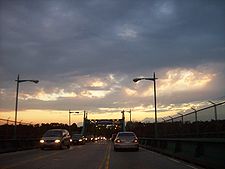 City Island is a small island approximately 1.5 mi (2.4 km) long by .5 mi (1 km) wide. At one time attached to the town of Pelham, Westchester County, it is now part of the New York City borough of the Bronx. As of the 2000 census the island had a population of 4,520. Its land area is 1.023 km (0.395 sq mi, or 252.835 acres). The island is part of Bronx Community Board 10.
City Island is a small island approximately 1.5 mi (2.4 km) long by .5 mi (1 km) wide. At one time attached to the town of Pelham, Westchester County, it is now part of the New York City borough of the Bronx. As of the 2000 census the island had a population of 4,520. Its land area is 1.023 km (0.395 sq mi, or 252.835 acres). The island is part of Bronx Community Board 10.
City Island is located at the extreme western end of Long Island Sound, south of Pelham Bay and east of Eastchester Bay. The body of water between City Island and the even smaller (and uninhabited) Hart Island to the east is known as City Island Harbor. The small island adjacent to the northeast is High Island. Stepping Stones Lighthouse, marking the main shipping channel into New York, is off the southern tip of the island, near the Long Island shore. It is part of the Pelham Islands, a group of islands originally belonging to Thomas Pell.
Originally inhabited by the Siwanoy band of Lenape Indians, City Island was later settled by Europeans as part of property and estate bought by English nobleman, Thomas Pell, in 1654. Prior to that, English settlers led by Anne Hutchinson (seeking religious freedom) settled in an area nearby on the river (now known as the Hutchinson River) in 1642.
After changing hands several times, in 1761 the Island (at that time known as Minefer’s Island), was bought by Benjamin Palmer of New York. Up to this point the island had been inhabited by only a few homes and farms. It had a population of about 1000 people, who tended farms and livestock. Palmer had the vision of developing the island into a port, which could rival that of New York. He knew that ships heading north and south passed City Island using Long Island Sound as a safe inshore waterway. He envisioned shipyards, and stores that could cater to the ships. He went as far as to have the island mapped out in different plots designated as shipyards, docks, business, farms, homes, schools, and houses of worship, along with streets, paths, and access routes. Benjamin Palmer appealed to the British Crown and received a patent that covered the ownership of waterfront properties 400′ out from the high tide mark under water, around the perimeter of the Island. This patent, known as the “Palmer Grant” is unique to City Island; it has been contested in courts since, but has always held up.
 Palmer is also responsible for changing the name from Minefer’s Island to City Island in anticipation of things to come. However, Palmer’s vision never fully materialized as the timing just before the American Revolution halted all progress, and the war depleted the capital of Palmer and his investors. It would be another sixty years before the island again started to be developed when oystermen, Hell-Gate pilots, and eventually shipbuilders arrived and introduced these industries.
Palmer is also responsible for changing the name from Minefer’s Island to City Island in anticipation of things to come. However, Palmer’s vision never fully materialized as the timing just before the American Revolution halted all progress, and the war depleted the capital of Palmer and his investors. It would be another sixty years before the island again started to be developed when oystermen, Hell-Gate pilots, and eventually shipbuilders arrived and introduced these industries.
